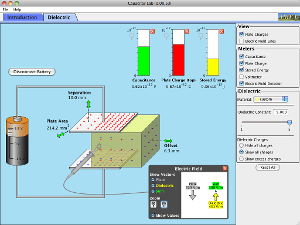Preparation for Physics C and College
| mit_lecture_notes_on_potential.pdf | |
| File Size: | 469 kb |
| File Type: | |
| mit_lecture_notes_on_capacitor.pdf | |
| File Size: | 1021 kb |
| File Type: | |
Java Applet 1
Java Applet 2
NOTE: You must be connected to the Internet to view this simulation!
DESCRIPTION: This simulation illustrates the interaction of charged particles inside the two plates of a capacitor. Each plate contains twelve charges interacting via the Coulomb and Pauli forces, where one plate contains positive charges and the other contains negative charges. Because of their mutual repulsion, the particles in each plate are compelled to maximize the distance between one another, and thus spread themselves evenly around the outer edge of their enclosure. However, the particles in one plate are attracted to the particles in the other, so they attempt to minimize the distance between themselves and their oppositely charged correspondants. Thus, they distribute themselves along the surface of their bounding box closest to the other plate.
VISUALIZATION: Start Simulation (you must have Java™ J2SE v1.4+ JRE installed. Mac OS X users need the Java3D update.)
